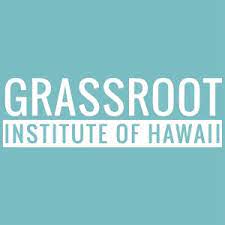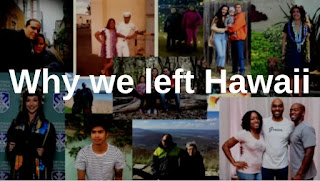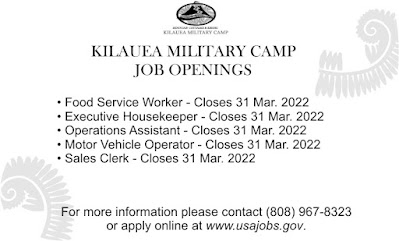HAWAI'I'S DECLINE IN POPULATION is the subject of a recent editorial from Grassroot Institute of
Hawai'i:
Hawai'i's population declined by 0.7% between July 2020 and July 2021, the third greatest per capita population decline in the country, according to new data released by the U.S. Census Bureau. Hawai'i trailed only New York, at -1.6%, and Illinois, at -0.9%. Hawai'i's net loss of 10,358 residents in fiscal 2021
2019.
"Hawai'i is one of the most beautiful places on the planet, yet residents continue to leave in search of better opportunities elsewhere," said Keliʻi Akina, president and CEO of the Grassroot Institute of Hawai'i. "If there are any state or county politicians who are not yet aware of this fact, let us hope that this latest information drives the point home."
According to the census data, Hawai'i had 1,441,553 residents as of July 2021, compared to 1,451,911 the previous year. This included 15,904 births and 14,648 deaths, for a "natural increase" of 1,256. The Bureau also estimated a net inflow of 1,077 people — including both immigrants and United States citizens returning from abroad — moving to Hawaii from international locations. All of the decline, then, came from continuing out-migration to the mainland, with the difference between people moving to and from the mainland equaling negative 12,603.
Early last year, 2020 census returns showed the state's population increasing from 2010 to 2020 by 7%. The timing and composition of this increase remain poorly understood, pending ongoing Census Bureau evaluation of the 2020 census and review of its population estimates for the previous decade, results of which are expected later this year.
In any case, the underlying reasons for Hawai'i's population loss persist. All data point to a steady out-migration of Hawai'i residents to the mainland throughout the past decade, increasing since 2016, and continuing this past year.For the most part, the reasons come down to Hawai'i's high cost of living, lack of housing and lack of job and business opportunities.
According to a 2019 survey by Pacific Resource Partnership, the main reasons people cited for leaving Hawai'i were its high cost of living, 86%, and the high cost of housing, 83%.
In 2020, the U.S. Bureau of Economic Analysis provided data showing Hawai'i's cost of living as the highest in the nation, 12% greater than the national average.
In 2021, the BEA found that Honolulu was one of the most expensive metropolitan areas in the country, with a cost of living 13% higher than the average metropolitan area.
The Grassroot Institute of Hawai'i's Why we left Hawai'i series documents the stories of dozens of people who felt compelled to say "Aloha" to Hawai'i. Here is what some former Hawai'i residents had to say:
"Most of my family is still in Hawai'i. A few are in different states. They moved for schools, low costs of living and higher pay," said Pearl Hori, now a resident of Lacey, Washington.
"I don't believe we could ever afford to live there again," said Kirk French, now a resident of Rural Hall, North Carolina. "We miss Hawai'i though."
"My family] moved to where housing and land is affordable. There are lots of job opportunities and better pay," said Eric Lee, now a resident of Apple Valley, Minnesota.
Said Akina: "With thousands of people leaving Hawai'i each year, it is well past time that the Legislature focus on policies that will lower the cost of living and expand opportunities. Lowering taxes, reducing barriers to new housing and pushing for Jones Act reform would be good places to start. We simply must create a better environment for our family, friends and neighbors, who right now seem to be seeing a better future for themselves just about anywhere but Hawai'i."
To read comments, add your own, and like this story, see www.facebook.com/kaucalendar/. See latest print edition at kaucalendar.com.
PEOPLE FROM AROUND THE ISLAND, INCLUDING KAʻŪ , ARE INVITED TO WEIGH IN ON THE FUTURE OF POHOIKI, ISAAC KEPO'OKALANI HALE BEACH PARK, the bay, surf spot, wharf and gathering place, partially covered by lava in the 2018 eruption. The boat ramp and gathering spot were popular with Kaʻū residents.
County Council member Asley Kierkiewicz, who represents the district that includes Pohoiki, said she wants to "thank the Pohoiki ‘ohana that have helped the County identify important elements and values to guide investments at Isaac Kepo‘okalani Hale Beach Park.” In total, $3 million in Federal and State
recovery funds are identified for Isaac Kepo‘okalani Hale Beach Park. By visiting https://revitalizepohoiki.consider.it, members of the public can give feedback by Jan. 31 on their vision for the park, partially inundated by lava during the 2018
eruption.
State Department of Land & Natural Resources is working on efforts to restore the Pohoiki Boat Ramp, blocked by a new sand beach formed by the eruption. DLNR representatives noted that dredging of the beach to restore access could start in about two years, with construction completion estimated to occur in November 2024. The project is currently in the permitting and design phase, with an environmental assessment being the next step. Creation of a safe swim area at Pohoiki will be considered as part of that review. Visit https://recovery.hawaiicounty.gov/infrastructure/ocean-access for more information.
On Tuesday, the County of Hawai‘i updated the community on Kīlauea eruption recovery efforts and unveiled an online engagement tool to help guide the future of Isaac Kepo‘okalani Hale Beach Park in Pohoiki. About 100 people participatedvia Zoom. Revitalize Puna is a collaboration between the County’s Disaster Recovery Division and Council District 4.
In-person Isaac Kepo‘okalani Hale Beach Park engagements will be at the following: Pāhoa Skate Park – Jan. 23, 7 a.m.-1 p.m.; Isaac K. Hale Beach Park – Jan. 27, 9 a.m.-noon; Hilo Coffee Mill – Feb. 5, 9 a.m.-2 p.m.; and Maku‘u Farmers Market – Feb. 13, 7 a.m.-1 p.m.
A virtual planning session will be held via Zoom from 3-5 p.m. Feb. 10. Members of the public can find more information on these in-person engagements and the virtual planning session at https://recovery.hawaiicounty.gov.
Plans will be submitted to the Federal Emergency Management Agency (FEMA) for funding assistance by May. Heart and Soul Statements about the area can be submitted online via https://padlet.com/aloha7/punaheartandsoul by Jan. 31.The County’s Department of Public Works is considering three options for construction of the lower Pohoiki Road alternate route to increase safety. None of these options would affect the protected exceptional mango trees located in the existing County right-of-way. However, some trees currently on private property and not considered exceptional trees per the County Code may need to be removed. The next step is to work with FEMA to initiate an environmental assessment for a combined road and waterline projects along Pohoiki Road and Highway 137. The County is considering repurposing the existing alignment to accommodate biking and walking. Visit https://recovery.hawaiicounty.gov/infrastructure/roads for more information.
County Parks & Recreation is receiving $4.9 million in Federal and State recovery assistance due to damage from the 2018 eruption. Funding is proposed for Isaac Kepo‘okalani Hale Beach Park ($3 million), equipment to ensure parks are safe and maintained ($1.76 million)Visit https://recovery.hawaiicounty.gov/infrastructure/parks for more.
County Council member Asley Kierkiewicz, who represents the district that includes Pohoiki, said she wants to "thank the Pohoiki ‘ohana that have helped the County identify important elements and values to guide investments at Isaac Kepo‘okalani Hale Beach Park.” In total, $3 million in Federal and State
recovery funds are identified for Isaac Kepo‘okalani Hale Beach Park. By visiting https://revitalizepohoiki.consider.it, members of the public can give feedback by Jan. 31 on their vision for the park, partially inundated by lava during the 2018
eruption.
 |
| Pohiki was a popular launch spot for fishing. Photo by Julia Neal |
State Department of Land & Natural Resources is working on efforts to restore the Pohoiki Boat Ramp, blocked by a new sand beach formed by the eruption. DLNR representatives noted that dredging of the beach to restore access could start in about two years, with construction completion estimated to occur in November 2024. The project is currently in the permitting and design phase, with an environmental assessment being the next step. Creation of a safe swim area at Pohoiki will be considered as part of that review. Visit https://recovery.hawaiicounty.gov/infrastructure/ocean-access for more information.
On Tuesday, the County of Hawai‘i updated the community on Kīlauea eruption recovery efforts and unveiled an online engagement tool to help guide the future of Isaac Kepo‘okalani Hale Beach Park in Pohoiki. About 100 people participatedvia Zoom. Revitalize Puna is a collaboration between the County’s Disaster Recovery Division and Council District 4.
In-person Isaac Kepo‘okalani Hale Beach Park engagements will be at the following: Pāhoa Skate Park – Jan. 23, 7 a.m.-1 p.m.; Isaac K. Hale Beach Park – Jan. 27, 9 a.m.-noon; Hilo Coffee Mill – Feb. 5, 9 a.m.-2 p.m.; and Maku‘u Farmers Market – Feb. 13, 7 a.m.-1 p.m.
A virtual planning session will be held via Zoom from 3-5 p.m. Feb. 10. Members of the public can find more information on these in-person engagements and the virtual planning session at https://recovery.hawaiicounty.gov.
 |
| Pohoiki was a favorite surf spot before lava filled the bay. Photo by Julia Neal |
Plans will be submitted to the Federal Emergency Management Agency (FEMA) for funding assistance by May. Heart and Soul Statements about the area can be submitted online via https://padlet.com/aloha7/punaheartandsoul by Jan. 31.The County’s Department of Public Works is considering three options for construction of the lower Pohoiki Road alternate route to increase safety. None of these options would affect the protected exceptional mango trees located in the existing County right-of-way. However, some trees currently on private property and not considered exceptional trees per the County Code may need to be removed. The next step is to work with FEMA to initiate an environmental assessment for a combined road and waterline projects along Pohoiki Road and Highway 137. The County is considering repurposing the existing alignment to accommodate biking and walking. Visit https://recovery.hawaiicounty.gov/infrastructure/roads for more information.
County Parks & Recreation is receiving $4.9 million in Federal and State recovery assistance due to damage from the 2018 eruption. Funding is proposed for Isaac Kepo‘okalani Hale Beach Park ($3 million), equipment to ensure parks are safe and maintained ($1.76 million)Visit https://recovery.hawaiicounty.gov/infrastructure/parks for more.
To read comments, add your own, and like this story, see www.facebook.com/kaucalendar/. See latest print edition at kaucalendar.com.
 |
| See archives of The Ka`u Calendar at www.kaucalendar.com and find the monthly print copy in mailboxes from Volcano through Ocean View. |























